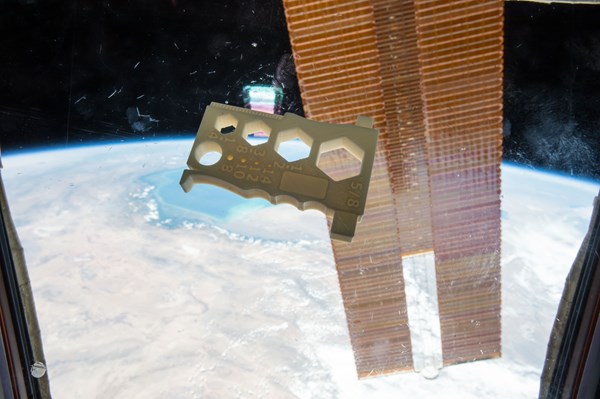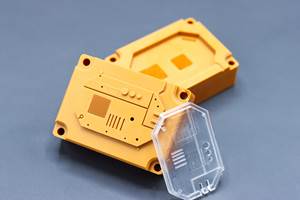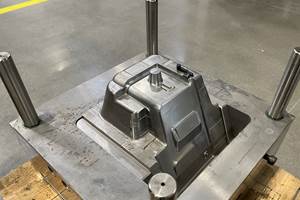NASA 3D Prints Plastic Design Tool in Space
NASA challenges students to upload and print a part astronauts can use on the 3D printer that's orbiting earth in International Space Station.

NASA challenges students to upload and print a part astronauts can use on the 3D printer orbiting earth in International Space Station.
The space agency has established its Additive Manufacturing Facility (AMF), which is a permanent feature in the International Space Station (ISS) to begin additional testing of 3D printing technology in orbit, since when a part breaks or a tool is misplaced in space, it is difficult and cost-prohibitive to send up a replacement.
Using replaceable subassemblies, the AMF can easily be upgraded to add new functionality and manufacturing methods in the future. The AMF is designed to last the entire lifetime of the ISS and the AMF printer can work with a wide range of various extrudable materials including flexible polymers and aerospace-grade composites.
NASA also has a focus on getting the next generation of engineers engaged in space. For instance, there’s the Future Engineers Space Tool design competition, which challenged students to create a device that astronauts could use in space. The catch was that it must upload electronically and print on the new 3D printer that was going to be installed on the orbiting laboratory.
In January 2015, NASA and the American Society of Mechanical Engineers Foundation announced that Robert Hillan's design, a multi-purpose precision maintenance tool, was selected out of hundreds of entries to be printed on the station.
Hillan's design features multiple tools on one plastic prototype compact unit, including different sized wrenches, drives to attach sockets, a precision measuring tool for wire gauges and a single-edged wire stripper. After the new manufacturing facility was installed on the station in March, NASA uploaded Hillan's design to be printed.
Hillan was invited to watch his tool come off the printer at NASA's Marshall Space Flight Center in Huntsville, Ala. Hillan watched as the NASA astronauts displayed the finished tool from the AMF. The Marshall Center is located just a few miles from where Hillan is a sophomore engineering student at the University of Alabama in Huntsville.
"I am extremely grateful that I was given the opportunity to design something for fabrication on the space station," Hillan said. "I have always had a passion for space exploration, and space travel in general. I designed the tool to adapt to different situations, and as a result I hope to see variants of the tool being used in the future, hopefully when it can be created using stronger materials."
Not only did Hillan get to watch his tool being made, he also got to spend a few minutes chatting with astronauts on the station. While talking to Hillan, astronaut Tim Kopra complimented his design and said, “One thing that often times comes up with prototyping with 3D printing is there’s a plastic version. But even this plastic version I think would work up to a certain torque value. So well done, I think it’s really cool.”
"When you have a problem, it will drive specific requirements and solutions. 3D printing allows you to do a quick design to meet those requirements. That's the beauty of this tool and this technology. You can produce something you hadn't anticipated and do it on short notice,” Kopra added.
The space station's 3D printer started operations in 2014 and built nearly two dozen sample designs that were returned to the Marshall Center for further testing. Now with the newly installed AMF, NASA is continuing 3D printing development that will prove helpful on the journey to Mars.
"When a part breaks or a tool is misplaced, it is difficult and cost-prohibitive to send up a replacement part," said Niki Werkheiser, NASA's 3D Printer program manager at Marshall. "With this technology, we can build what is needed on demand instead of waiting for resupply. We may even be able to build entire structures using materials we find on Mars."
"When I won the competition, I started seeing problems I face as new opportunities to create and learn," Hillan said. "Since then I have tried to seize every opportunity that presents itself. I love finding solutions to problems, and I want to apply that mentality as I pursue my engineering degree and someday launch my own company."
Here’s the video of Hillan’s exchange with the astronauts. You can see the 3D-printed tool float in space!
Related Content
Make Every Shot Count: Mold Simulation Maximizes Functional Parts From Printed Tooling
If a printed tool only has a finite number of shots in it, why waste any of them on process development?
Read MoreBMW Group Vehicle to Adopt 3D Printed Center Console
A vehicle coming to market in 2027 will include a center console carrier manufactured through polymer robot-based large-format additive manufacturing (LFAM).
Read MoreInsight Polymers & Compounding Unveils New Conductive Products Line
The new conductive products line will also be produced for injection molding and extrusion.
Read MoreDaimler, OMIC Evaluate Wire-Fed DED for Moldmaking
3D printing a core and cavity on machine from Gefertec, followed by machining, allowed for a complete mold tool to be produced in three days.
Read MoreRead Next
People 4.0 – How to Get Buy-In from Your Staff for Industry 4.0 Systems
Implementing a production monitoring system as the foundation of a ‘smart factory’ is about integrating people with new technology as much as it is about integrating machines and computers. Here are tips from a company that has gone through the process.
Read MoreSee Recyclers Close the Loop on Trade Show Production Scrap at NPE2024
A collaboration between show organizer PLASTICS, recycler CPR and size reduction experts WEIMA and Conair recovered and recycled all production scrap at NPE2024.
Read More












